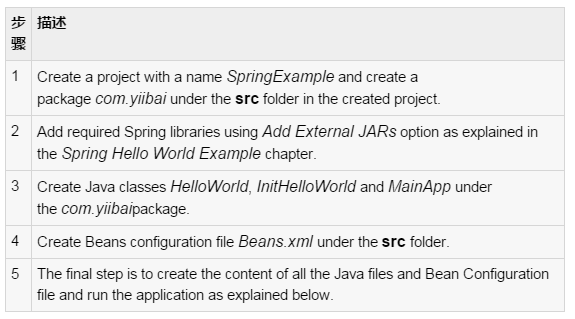BeanPostProcessor 的接口定义,可以实现提供自己的实例化逻辑,依赖解析逻辑等,也可以以后在Spring容器实例化完毕,配置和初始化一个bean通过插入一个或多个的BeanPostProcessor实现一些自定义逻辑回调方法实现。
可以配置多个的BeanPostProcessor接口,控制这些的BeanPostProcessor接口,通过设置属性顺序执行顺序提供的BeanPostProcessor实现了Ordered接口。
BeanPostProcessor可以对bean(或对象)操作实例,这意味着Spring IoC容器实例化一个bean实例,然后BeanPostProcessor的接口做好自己的工作。
ApplicationContext会自动检测已定义实现的BeanPostProcessor接口和注册这些bean类为后置处理器,可然后通过在容器创建bean,在适当时候调用任何bean。
示例:
下面的示例显示如何编写,注册和使用BeanPostProcessor 可以在一个ApplicationContext 的上下文。
使用Eclipse IDE,然后按照下面的步骤来创建一个Spring应用程序:

这里是 HelloWorld.java 文件的内容:
|
1
2
3
4
5
6
7
8
9
10
11
12
13
14
15
16
17
18
19
20
21
|
package com.yiibai;public class HelloWorld { private String message; public void setMessage(String message){ this.message = message; } public void getMessage(){ System.out.println("Your Message : " + message); } public void init(){ System.out.println("Bean is going through init."); } public void destroy(){ System.out.println("Bean will destroy now."); }} |
这是实现BeanPostProcessor,之前和之后的任何bean的初始化它打印一个bean的名字非常简单的例子。可以因为有两个后处理器的方法对内部bean对象访问之前和实例化一个bean后执行更复杂的逻辑。
这里是InitHelloWorld.java文件的内容:
|
1
2
3
4
5
6
7
8
9
10
11
12
13
14
15
16
17
18
19
20
|
package com.yiibai;import org.springframework.beans.factory.config.BeanPostProcessor;import org.springframework.beans.BeansException;public class InitHelloWorld implements BeanPostProcessor { public Object postProcessBeforeInitialization(Object bean, String beanName) throws BeansException { System.out.println("BeforeInitialization : " + beanName); return bean; // you can return any other object as well } public Object postProcessAfterInitialization(Object bean, String beanName) throws BeansException { System.out.println("AfterInitialization : " + beanName); return bean; // you can return any other object as well }} |
以下是MainApp.java 文件的内容。在这里,需要注册一个关闭挂钩registerShutdownHook() 是在AbstractApplicationContext类中声明的方法。这将确保正常关闭,并调用相关的destroy方法。
|
1
2
3
4
5
6
7
8
9
10
11
12
13
14
15
16
|
package com.yiibai;import org.springframework.context.support.AbstractApplicationContext;import org.springframework.context.support.ClassPathXmlApplicationContext;public class MainApp { public static void main(String[] args) { AbstractApplicationContext context = new ClassPathXmlApplicationContext("Beans.xml"); HelloWorld obj = (HelloWorld) context.getBean("helloWorld"); obj.getMessage(); context.registerShutdownHook(); }} |
下面是init和destroy方法需要的配置文件beans.xml文件:
|
1
2
3
4
5
6
7
8
9
10
11
12
13
14
15
|
<?xml version="1.0" encoding="UTF-8"?><beans xmlns="http://www.springframework.org/schema/beans" xmlns:xsi="http://www.w3.org/2001/XMLSchema-instance" xsi:schemaLocation="http://www.springframework.org/schema/beans http://www.springframework.org/schema/beans/spring-beans-3.0.xsd"> <bean id="helloWorld" class="com.yiibai.HelloWorld" init-method="init" destroy-method="destroy"> <property name="message" value="Hello World!"/> </bean> <bean class="com.yiibai.InitHelloWorld" /></beans> |
创建源代码和bean配置文件完成后,让我们运行应用程序。如果一切顺利,这将打印以下信息:
|
1
2
3
4
5
|
BeforeInitialization : helloWorldBean is going through init.AfterInitialization : helloWorldYour Message : Hello World!Bean will destroy now. |













